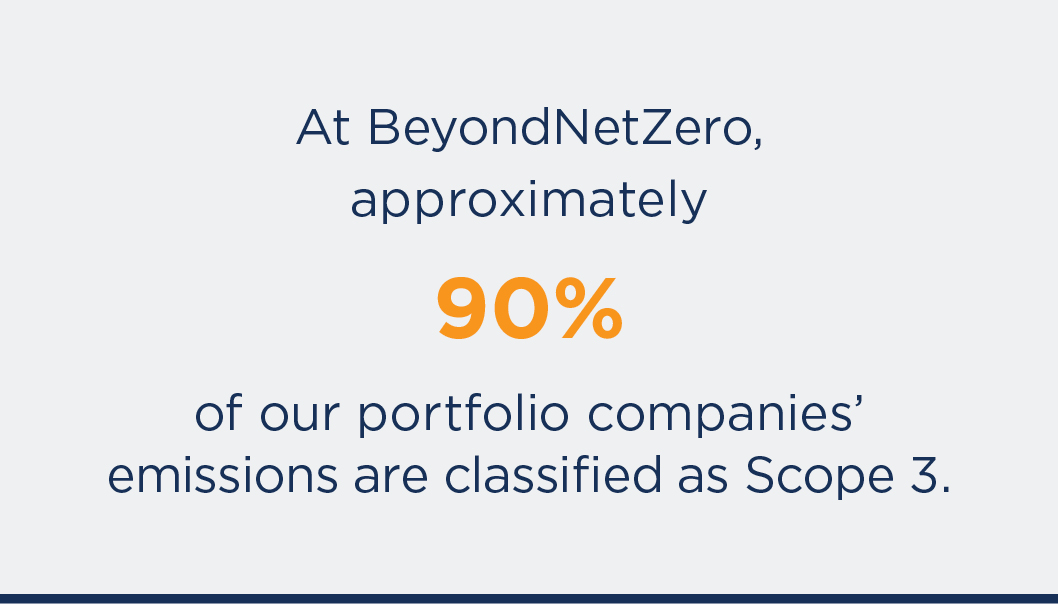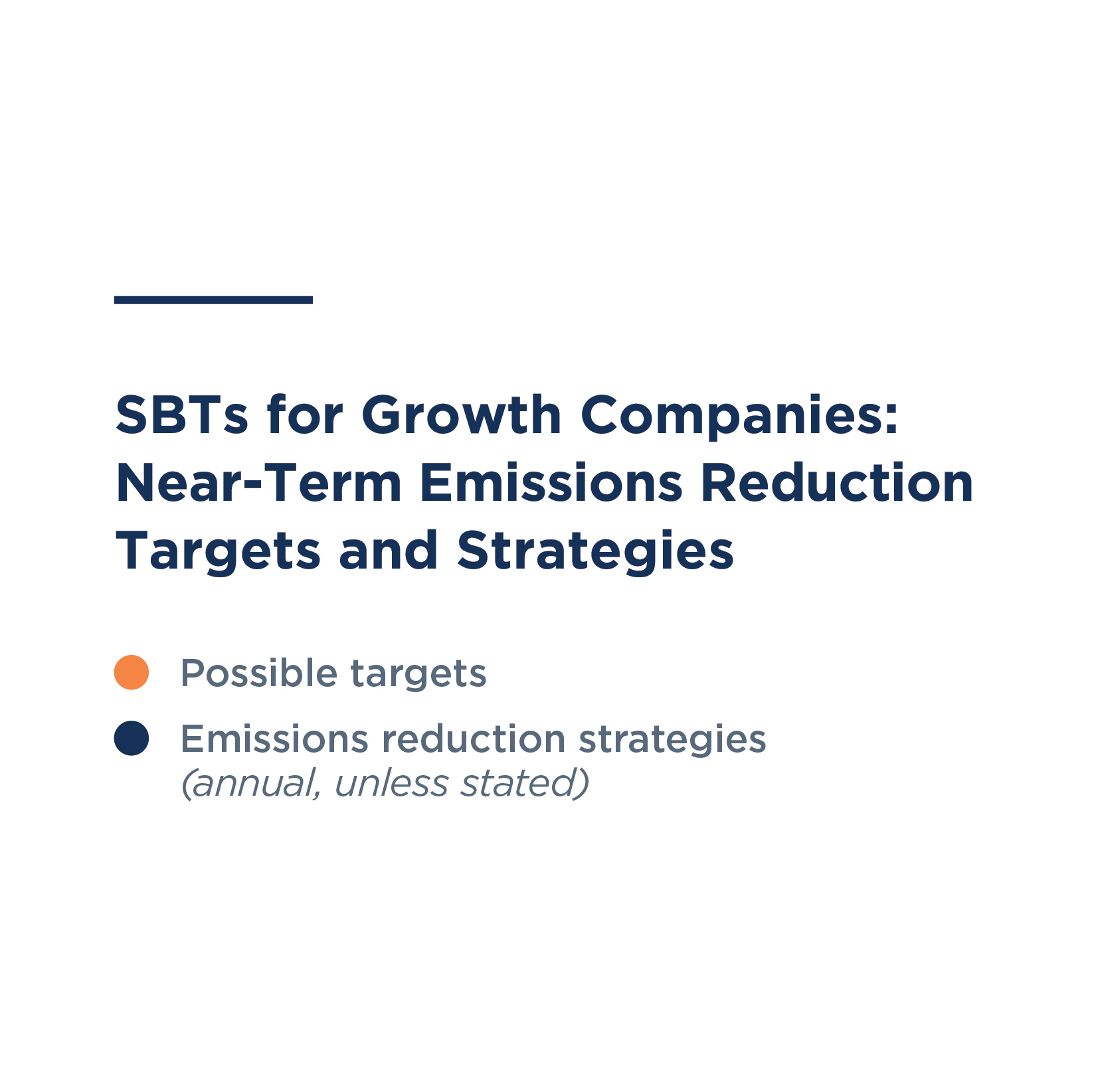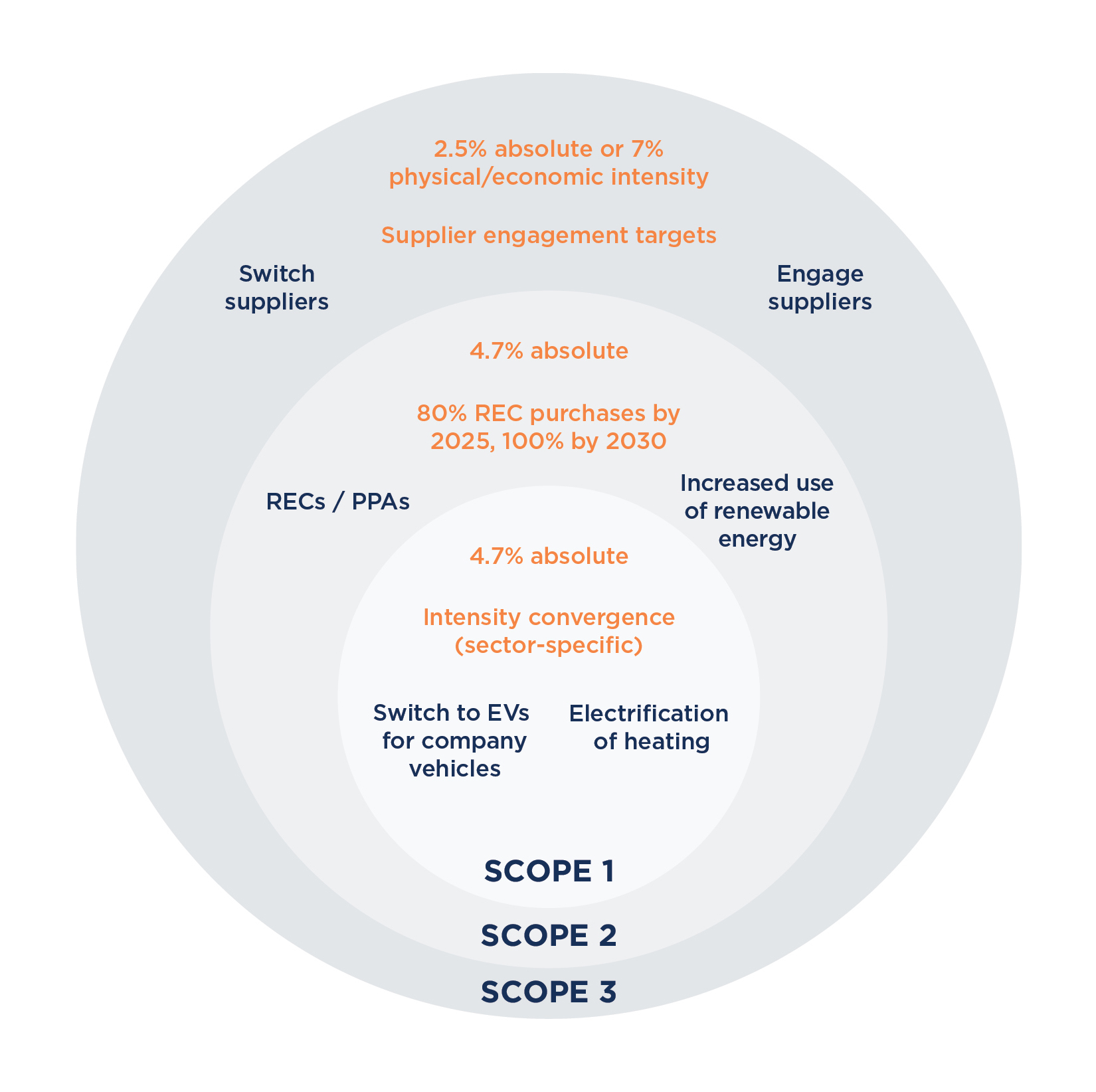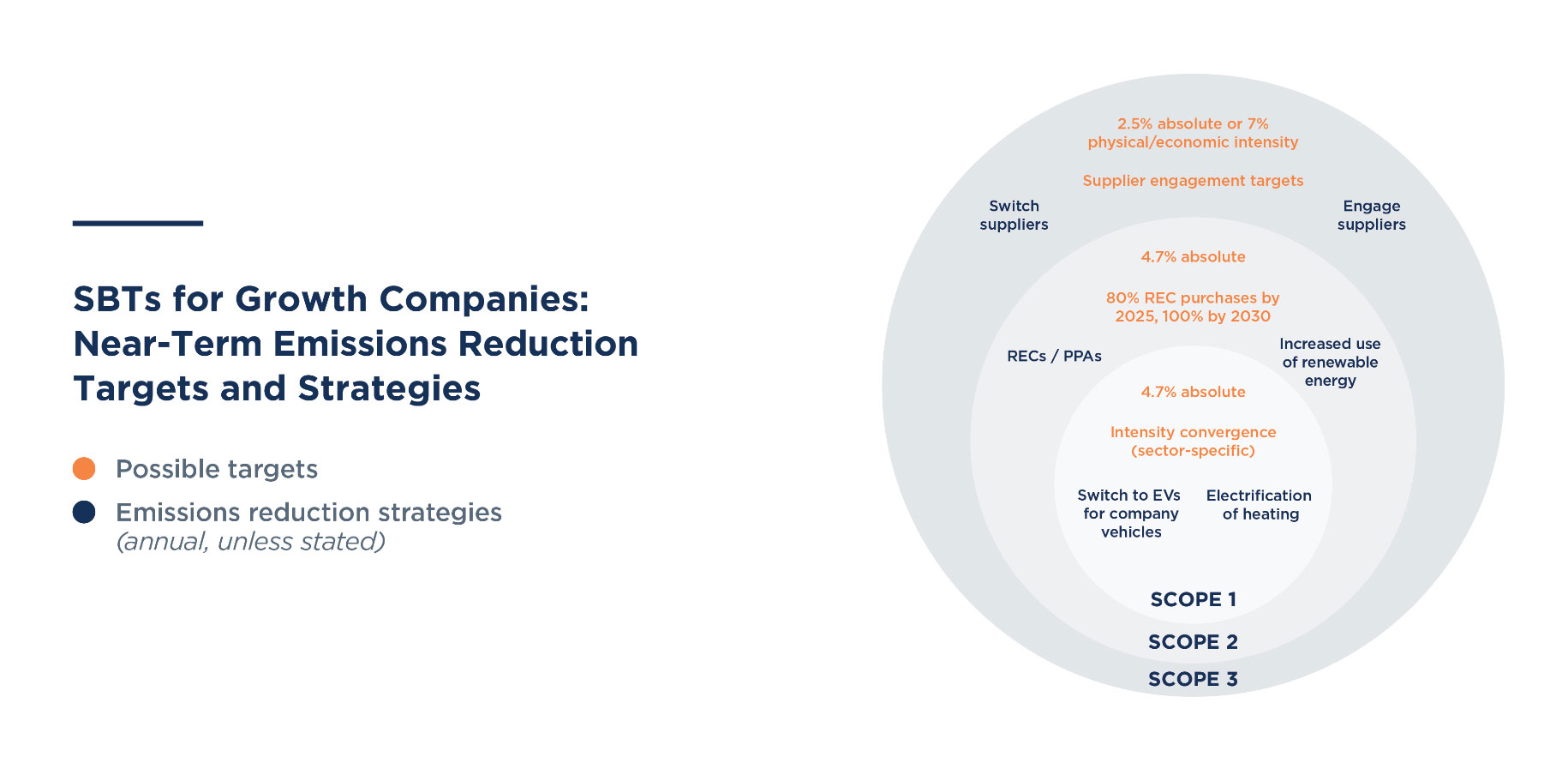Setting Science-Based Targets for Growth Companies

By The BEYONDNETZERO Team
States, regions and cities are scaling up efforts to decarbonize the economy. National emissions reduction pledges now cover 90% of global emissions and 80% of the world’s population.1 Furthermore, more than one-third of the largest publicly traded companies have committed to reaching net zero by 2050.2 However, despite these public commitments, most companies today do not have a clear plan for the decarbonization of their operations. Setting emissions reduction targets is the first step in bridging the gap between the present and the future.
At BeyondNetZero, we are investing in companies delivering climate solutions. We decided from the outset that our portfolio companies must themselves be on a pathway to net zero emissions — irrespective of the positive climate impact of their products and services. Credibility is threatened when companies claim “avoided emissions”3 without decarbonizing their own footprint at the same time. That is why we require all portfolio companies to set Science-Based Targets using the respected and widely applicable roadmap laid out by the Science-Based Target initiative (SBTi). Companies without existing targets are given a year from investment to signal their commitment and begin the journey, with assistance from BeyondNetZero and our strategic partner, Systemiq.
Over the past year, we have worked with five portfolio companies at different stages in their decarbonization journeys. This has provided insight into how the SBTi’s approach can be applied to high-growth companies, all of which face the same challenge: how to achieve sustained growth while reducing their greenhouse gas emissions.
In the near term, it is unlikely that overall emissions can be prevented from rising, as we expect these companies to grow and gain market share at a faster rate than that at which emissions reduction initiatives can be implemented. But this does not mean that setting an SBT is pointless. On the contrary, identifying emissions hotspots and setting targets early on can help guide the company’s actions and investments to decouple revenues from emissions, thereby future-proofing the company’s growth. The SBTi has designed guidance with exactly this issue in mind, so companies do not need to wait until growth slows before identifying decarbonization levers and setting SBTs.
The SBTi’s 3-Step Process
- The company writes a commitment letter, stating its intent to set targets.
- The company has two years to develop 1.5˚C aligned emissions reduction targets that are both ambitious and feasible. Target development has several components: the selection of an emissions baseline year; the scopes of emissions being considered, as defined by the Greenhouse Gas Protocol; the target setting method; and the timeframe to which the targets correspond.
- The SBTi validates the company’s targets.
The SBTi recognizes that companies will decarbonize at different rates depending on their industry and size. To account for this, sector-specific pathways and a small/medium enterprise pathway have been developed to complement the generic, cross-sector pathway. Most companies are required to set absolute reduction targets for Scopes 1 and 2 emissions in the near term (5-10 years after the target is set), and all scopes in the long term (by 2050). Companies often choose to set intensity targets for Scope 3 emissions in the near term. Once targets are approved by the SBTi, the company announces them publicly, works on their implementation, and discloses progress on a yearly basis.
As BeyondNetZero has followed this process with five portfolio companies, we have seen firsthand the ways in which rapidly growing organizations are tackling the challenge of emissions reduction within the framework laid out by the SBTi. We offer below four lessons based on our experience.
Four Lessons Learned
1. Emissions intensity targets are an essential component of near-term decarbonization.
Most greenhouse gas emissions come from suppliers and customers as opposed to being a direct product of company operations; this is especially true for low-capex companies on a high-growth trajectory. Companies like these often lack data on the emissions of their suppliers, and lack control or influence over the actions of their suppliers.
The SBTi offers an approach that takes account of such difficulties while maintaining the overall integrity of the emissions reduction process. In the near term, companies are generally required to make absolute reductions to their Scopes 1 and 2 emissions of 4.7% every year, but when it comes to Scope 3 emissions — those which they do not necessarily control — the SBTi allows them either to make absolute reductions of 2.5% every year, or to reduce the emissions intensity of a chosen measure of physical or economic output (e.g., gross profit) by 7% every year.
Intensity targets give companies flexibility in tackling the most material sources of emissions. They recognize that while it is essential to deliver absolute emissions reductions in the long term, a company’s emissions might unavoidably rise in the short term as they grow rapidly and take market share from their competitors. At BeyondNetZero, for example, one of our portfolio companies is pledging to reduce the emissions intensity of its core product by 50% between 2019 and 2026 while its underlying Scope 3 emissions are expected to rise over the same period.
Intensity targets are a practical approach to growing low-carbon businesses and a critical contributor to near-term decarbonization. They can also help an organization kick-start its efforts to deliver the absolute reductions in emissions that are needed in the long term. The SBTi’s guidelines for the use of intensity targets vary across sectors, and their evolution should be monitored carefully.
2. There are several potential strategies to reduce supply chain emissions.
There are two ways for companies to reduce emissions in their supply chains. They can switch suppliers to those with less carbon-intensive processes, or they can encourage their suppliers to set decarbonization targets of their own. Explicit supplier engagement objectives can be part of an SBTi-approved Scope 3 target. Target achievement will depend on the company’s ability to encourage suppliers to set targets of their own and start implementing best practices. Hypothetically, if all companies were to eliminate their Scope 1 and 2 emissions, then Scope 3 emissions would cease to exist and global value chains would converge towards net zero. Engagement seeks to accelerate this convergence process.
While small but rapidly growing companies might not benefit from the same influence that larger corporations can exercise, they can nonetheless shift the needle in other ways. They can take part in programs that facilitate data collection and exchange, in the knowledge that collaboration, transparency and trust are critical to eliminating Scope 3 emissions. As smaller players with lower reputational risks, they can voice concerns more freely to suppliers and industry leaders, and they can urge larger players to take a leadership role. They can also work with service providers to identify and address bottlenecks in their supply chains.
Some Scope 3 emissions, however, lack feasible mitigants. One of BeyondNetZero’s portfolio companies has significant Scope 3 emissions from a sector which is inherently slow in its decarbonization journey and will therefore continue to be a major source of emissions in the near term. Intensity or supplier engagement targets provide an impetus for action, while giving companies time to find the technologies or strategies to deliver absolute emissions reductions. Alternatively, companies can follow the SBTi’s sector-specific pathways, which were designed to avoid setting such companies up for failure while aligning with a 1.5˚C future.
3. Renewable electricity certificates can be used to address Scope 2 emissions while renewables ramp up.
One consistent feature of high-growth companies is that the number of facilities they operate will likely increase in the short to medium term. This will increase the amount of energy used and often drive up Scope 2 emissions (those from purchased or acquired electricity, steam, heat and cooling) — a category that is required to decline in absolute terms in order for companies to meet their SBTs. One of BeyondNetZero’s portfolio companies is in the process of developing its emissions reduction targets but is also managing the construction of new facilities in regions with carbon-intensive electricity grids. Once operational, these will immediately and significantly increase the company’s Scope 2 emissions.
A short-term solution to the projected rise in Scope 2 emissions is the use of Renewable Electricity Certificates (RECs)4. One REC equates to one megawatt-hour of renewable electricity generation; its purchase indicates that renewables have entered the grid at a given time (though not necessarily the time, or the location, that the energy was used). The SBTi has set thresholds for companies of 80% renewable electricity procurement by 2025 and 100% by 2030, meaning that a company with 0% low-carbon electricity in its operations in 2030 would need to purchase a REC or a Power Purchase Agreement (PPA) for every MWh of electricity it consumes. BeyondNetZero expects and encourages portfolio companies to combine the acquisition of RECs and PPAs with tangible efforts to increase their access to renewable power through investment and a strategic approach to international expansion that takes the emissions intensity of local grids into account.
4. Avoided emissions are critical, but are not a substitute for decarbonization.
Many climate solution companies are not just seeking to decarbonize their value chain; they are also generating “avoided emissions,” which occur when a company’s products or services are lower-carbon than the incumbent. When our portfolio company Sun King installs a solar home system in Africa, for example, it replaces a carbon-intensive kerosene lamp or diesel generator. This means that its operations inherently contribute to emissions reductions beyond its value chain.
We believe that companies should maximize avoided emissions, as this contributes to economy-wide decarbonization; indeed, it is part of BeyondNetZero’s mission and mandate. This aligns with the SBTi’s belief and expectation that companies should invest in mitigation beyond their value chains to support societal efforts to deliver net zero. However, avoided emissions do not negate the need to meet SBTs. Every company — its mission and wider impact notwithstanding — will need to align with climate science and work towards the 1.5˚C mark if we are to achieve our global goals.
Laying the Groundwork for Growth
Companies should not expect to find a one-size-fits-all solution to their decarbonization efforts. The decarbonization pathways of companies will vary significantly depending on a plethora of factors that range from the nature of their industry and sector to their stage of development or their geographical location. Inevitably, some companies will grow at a speed that is higher than the rate at which they can decarbonize its operations. However, this should not be used as an excuse to delay action. Companies that are taking steps now to measure emissions, work through the target-setting process, engage suppliers and implement abatement strategies will be able to future-proof their growth by decoupling revenues from emissions at an early stage. We do not expect our portfolio companies to have all the answers today, but we want to help them lay the groundwork for growth that is profitable, sustainable and consistent with a net zero world.
To continue the conversation, please reach out to Matthew Powell, Head of ESG and Reporting, BeyondNetZero: [email protected].
1. https://zerotracker.net/insights/pr-net-zero-stocktake-2022
2. https://zerotracker.net/insights/pr-net-zero-stocktake-2022
3. Avoided emissions are emission reductions that occur outside of a product’s life cycle or value chain, as a result of the use of that product. Examples of products that avoid emissions include low-temperature detergents, fuel-saving tyres, energy-efficient ball bearings, and teleconferencing services.
4. https://www.irecstandard.org/what-are-recs/




